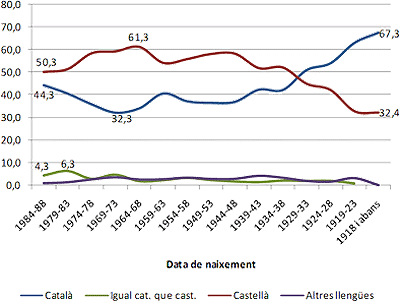
Home,
school and playground: linguistic usages when lessons are over.
Summary and analysis of the socio-demographic and study at secondary
schools in Catalonia, by Natxo Sorolla |
||||
| CONTINUA |
By contrast, the secondary school study detects an increase in speakers who state that their initial language is both Catalan and Spanish (14.1%). This growth, which is comparatively very considerable, is not entirely surprising. In the adult population study (EULC 2003) this growth is only suspected as a trend, as until the cohorts born during the '70s the number of initial speakers of both languages did not reach 4%. In addition, although in the most recent age groups (those born during the '80s) this percentage might outline an increasing trend, it does so in a rather unclear way. So, the secondary school study would indicate that this increase, beginning in the form of a trend in the '70s, has been significantly consolidated among the generations born at the beginning of the '90s, where the number of initial speakers of both languages would be growing noticeably. Graph 2 – Do you remember which language you first spoke at home when you were little? according to the age of the person surveyed. Statistics on language usages in Catalonia, 2003
If we include other variables in the analysis, it is possible to profile in a little more detail the characteristics of the group of secondary school students whose initial language is Catalan. On one hand, we should highlight, as might be expected, the presence of initial Catalan-speakers among pupils born in Catalonia, as well as among those studying at private schools, those who have parents with university education, those with a mother working full-time outside the home, or those from medium-sized towns (between 10,000 and 100,000 inhabitants) or small ones (less than 10,000 inhabitants). Comparing their initial language (“Do you remember which language you spoke at home when you were little?”) with the identification language (“What is your language?”), we see that the number of answers with the two languages combined increases (27.5%). By contrast, Spanish as identification language (33.6%) is 9.3 percentage points below the percentage of initial Spanish-speakers (42.9 %). In the case of Catalan, the reduction is much smaller, with 36.5% of pupils identifying with this language. The factors which most influence this difference between the initial language and the identification language in favour of those who identify with both languages at the same time, or even those who identify only or above all with Catalan, are the type of school and the size of the town, with public schools and smaller towns showing the biggest increases in Catalan as identification language. We detect that Catalan has a certain capacity for attraction, in comparing the language that mothers and fathers speak with one another and the initial language declared by the pupils. This happens because a noticeable group of pupils – 7.5% of those surveyed – state that Catalan is their initial language even though their parents do not speak it with one another. This positive flow towards Catalan from other languages and combinations does not go unnoticed as a positive indicator on the inter-generational transmission of Catalan in the population cohorts born at the beginning of the '90s. Family language usages, meanwhile, show notable complexity, above
all because of the interpretation of the concept of initial language
in the population of young people. Although a broad correlation
can be detected in the adult population between the language spoken
with parents and the initial language, younger generations show
some changes that do not go unnoticed. It has been shown that there
are important differences between the language pupils speak with
their parents and the language they state was the first they spoke
at home when they were small (initial language). The two variables
do not always correlate as much as might be predicted. 34.4% of
pupils speak Catalan with both parents, 5.5 points less than the
39.9% of initial Catalan-speakers. Meanwhile, in the Spanish-speaking
group, no significant difference is detected between the language
spoken with parents (44.6%) and the initial language (42.9%). |
||
